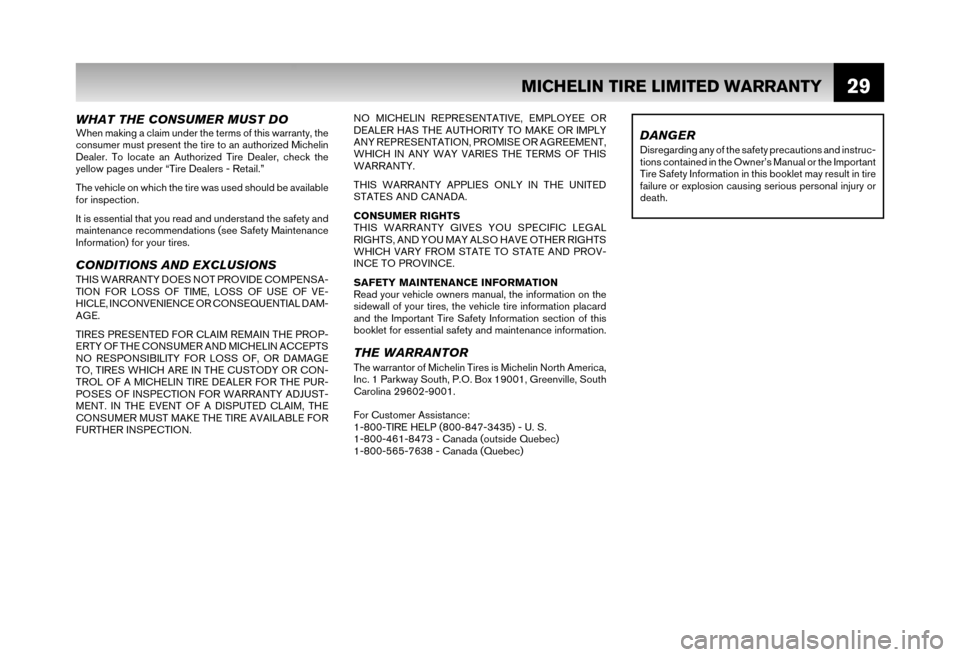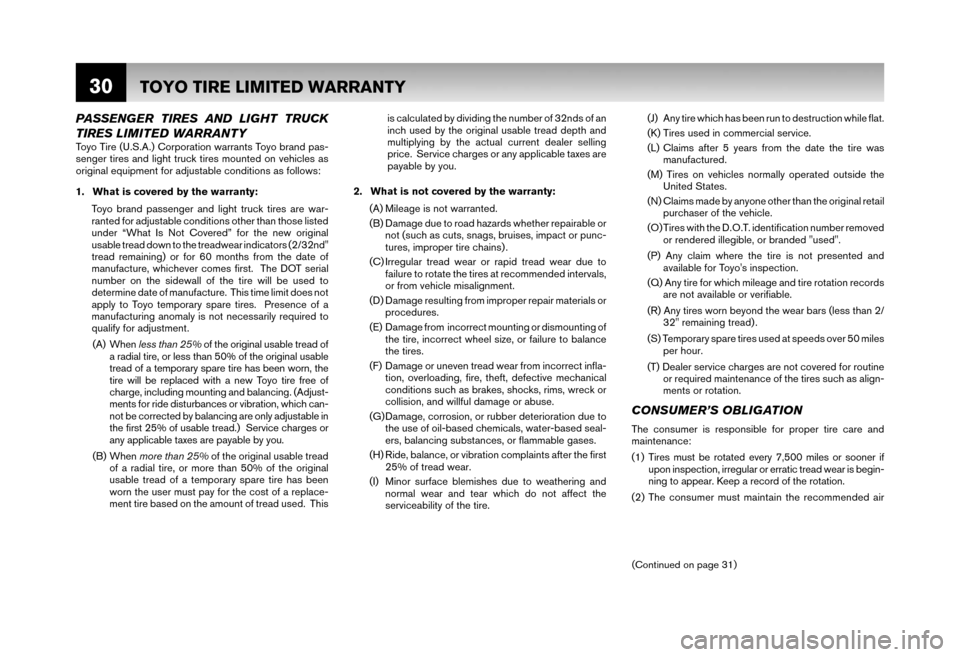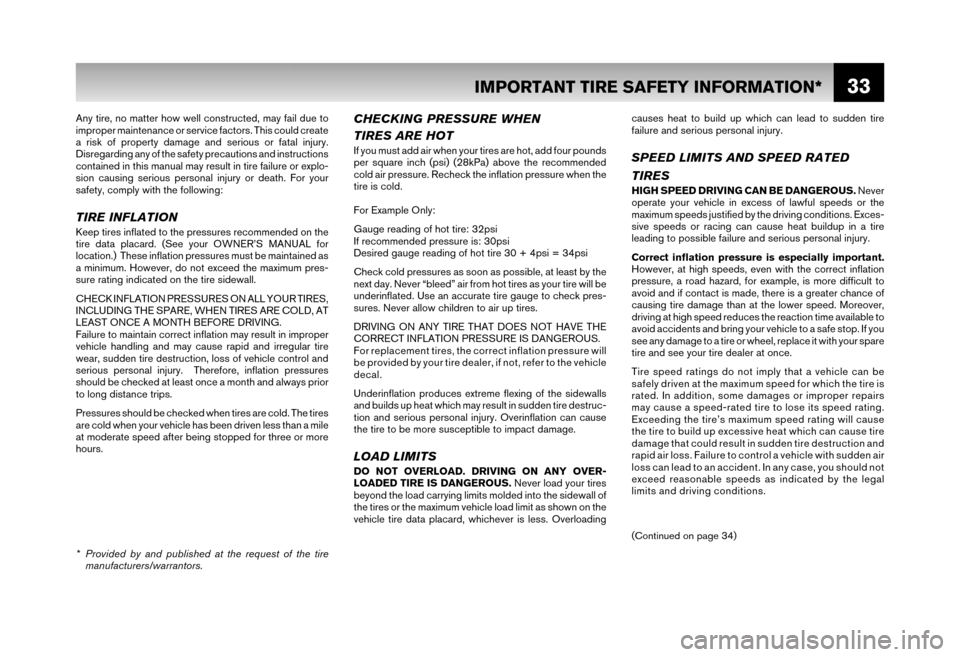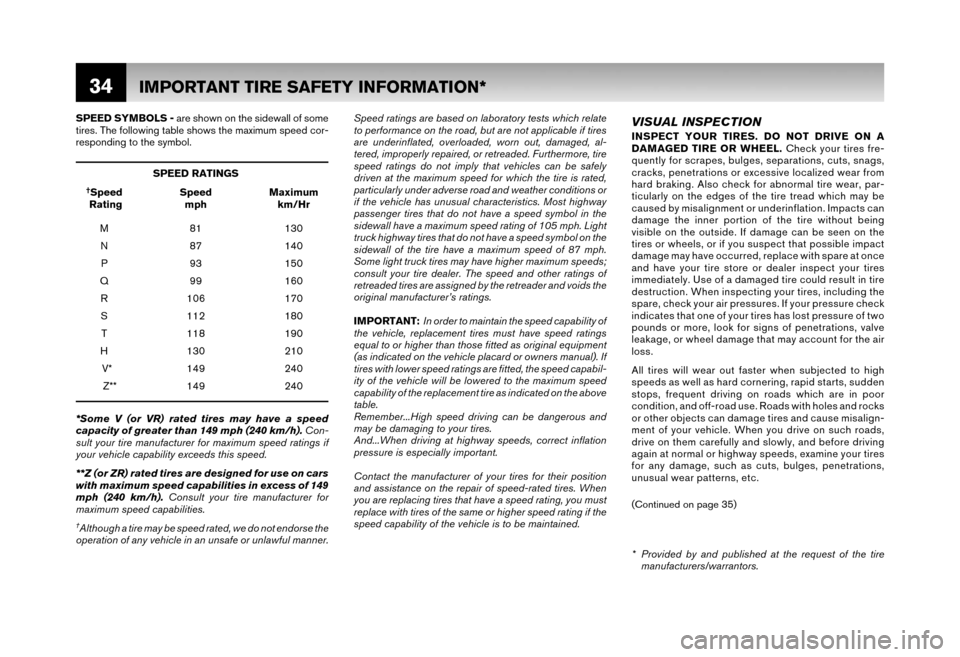2006 NISSAN XTERRA ESP
[x] Cancel search: ESPPage 34 of 55

29
WHAT THE CONSUMER MUST DOWhen making a claim under the terms of this warranty, the
consumer must present the tire to an authorized Michelin
Dealer. To locate an Authorized Tire Dealer, check the
yellow pages under “Tire Dealers - Retail.”
The vehicle on which the tire was used should be available
for inspection.
It is essential that you read and understand the safety and
maintenance recommendations (see Safety Maintenance
Information) for your tires.
CONDITIONS AND EXCLUSIONS
THIS WARRANTY DOES NOT PROVIDE COMPENSA-
TION FOR LOSS OF TIME, LOSS OF USE OF VE-
HICLE, INCONVENIENCE OR CONSEQUENTIAL DAM-
AGE.
TIRES PRESENTED FOR CLAIM REMAIN THE PROP-
ERTY OF THE CONSUMER AND MICHELIN ACCEPTS
NO RESPONSIBILITY FOR LOSS OF, OR DAMAGE
TO, TIRES WHICH ARE IN THE CUSTODY OR CON-
TROL OF A MICHELIN TIRE DEALER FOR THE PUR-
POSES OF INSPECTION FOR WARRANTY ADJUST-
MENT. IN THE EVENT OF A DISPUTED CLAIM, THE
CONSUMER MUST MAKE THE TIRE AVAILABLE FOR
FURTHER INSPECTION. NO MICHELIN REPRESENTATIVE, EMPLOYEE OR
DEALER HAS THE AUTHORITY TO MAKE OR IMPLY
ANY REPRESENTATION, PROMISE OR AGREEMENT,
WHICH IN ANY WAY VARIES THE TERMS OF THIS
WARRANTY.
THIS WARRANTY APPLIES ONLY IN THE UNITED
STATES AND CANADA.
CONSUMER RIGHTS
THIS WARRANTY GIVES YOU SPECIFIC LEGAL
RIGHTS, AND YOU MAY ALSO HAVE OTHER RIGHTS
WHICH VARY FROM STATE TO STATE AND PROV-
INCE TO PROVINCE.
SAFETY MAINTENANCE INFORMATION
Read your vehicle owners manual, the information on the
sidewall of your tires, the vehicle tire information placard
and the Important Tire Safety Information section of this
booklet for essential safety and maintenance information.
THE WARRANTORThe warrantor of Michelin Tires is Michelin North America,
Inc. 1 Parkway South, P.O. Box 19001, Greenville, South
Carolina 29602-9001.
For Customer Assistance:
1-800-TIRE HELP (800-847-3435) - U. S.
1-800-461-8473 - Canada (outside Quebec)
1-800-565-7638 - Canada (Quebec)
DANGERDisregarding any of the safety precautions and instruc-
tions contained in the Owner’s Manual or the Important
Tire Safety Information in this booklet may result in tire
failure or explosion causing serious personal injury or
death.
MICHELIN TIRE LIMITED WARRANTY
Page 35 of 55

30
PASSENGER TIRES AND LIGHT TRUCK
TIRES LIMITED WARRANTY
Toyo Tire (U.S.A.) Corporation warrants Toyo brand pas-
senger tires and light truck tires mounted on vehicles as
original equipment for adjustable conditions as follows:
1. What is covered by the warranty:
Toyo brand passenger and light truck tires are war-
ranted for adjustable conditions other than those listed
under “What Is Not Covered” for the new original
usable tread down to the treadwear indicators (2/32nd"
tread remaining) or for 60 months from the date of
manufacture, whichever comes first. The DOT serial
number on the sidewall of the tire will be used to
determine date of manufacture. This time limit does not
apply to Toyo temporary spare tires. Presence of a
manufacturing anomaly is not necessarily required to
qualify for adjustment. (A) When less than 25% of the original usable tread of
a radial tire, or less than 50% of the original usable
tread of a temporary spare tire has been worn, the
tire will be replaced with a new Toyo tire free of
charge, including mounting and balancing. (Adjust-
ments for ride disturbances or vibration, which can-
not be corrected by balancing are only adjustable in
the first 25% of usable tread.) Service charges or
any applicable taxes are payable by you.
(B) When more than 25% of the original usable tread
of a radial tire, or more than 50% of the original
usable tread of a temporary spare tire has been
worn the user must pay for the cost of a replace-
ment tire based on the amount of tread used. This is calculated by dividing the number of 32nds of an
inch used by the original usable tread depth and
multiplying by the actual current dealer selling
price. Service charges or any applicable taxes are
payable by you.
2. What is not covered by the warranty: (A) Mileage is not warranted.
(B) Damage due to road hazards whether repairable or not (such as cuts, snags, bruises, impact or punc-
tures, improper tire chains) .
(C) Irregular tread wear or rapid tread wear due to failure to rotate the tires at recommended intervals,
or from vehicle misalignment.
(D) Damage resulting from improper repair materials or procedures.
(E) Damage from incorrect mounting or dismounting of the tire, incorrect wheel size, or failure to balance
the tires.
(F) Damage or uneven tread wear from incorrect infla- tion, overloading, fire, theft, defective mechanical
conditions such as brakes, shocks, rims, wreck or
collision, and willful damage or abuse.
(G) Damage, corrosion, or rubber deterioration due to the use of oil-based chemicals, water-based seal-
ers, balancing substances, or flammable gases.
(H) Ride, balance, or vibration complaints after the first 25% of tread wear.
(I) Minor surface blemishes due to weathering and normal wear and tear which do not affect the
serviceability of the tire. (J) Any tire which has been run to destruction while flat.
(K) Tires used in commercial service.
(L) Claims after 5 years from the date the tire was
manufactured.
(M) Tires on vehicles normally operated outside the United States.
(N) Claims made by anyone other than the original retail purchaser of the vehicle.
(O) Tires with the D.O.T. identification number removed or rendered illegible, or branded "used".
(P) Any claim where the tire is not presented and available for Toyo's inspection.
(Q) Any tire for which mileage and tire rotation records are not available or verifiable.
(R) Any tires worn beyond the wear bars (less than 2/ 32" remaining tread) .
(S) Temporary spare tires used at speeds over 50 miles per hour.
(T) Dealer service charges are not covered for routine or required maintenance of the tires such as align-
ments or rotation.
CONSUMER’S OBLIGATION
The consumer is responsible for proper tire care and
maintenance:
(1) Tires must be rotated every 7,500 miles or sooner if upon inspection, irregular or erratic tread wear is begin-
ning to appear. Keep a record of the rotation.
(2) The consumer must maintain the recommended air
TOYO TIRE LIMITED WARRANTY
(Continued on page 31)
Page 38 of 55

33
Any tire, no matter how well constructed, may fail due to
improper maintenance or service factors. This could create
a risk of property damage and serious or fatal injury.
Disregarding any of the safety precautions and instructions
contained in this manual may result in tire failure or explo-
sion causing serious personal injury or death. For your
safety, comply with the following:
TIRE INFLATIONKeep tires inflated to the pressures recommended on the
tire data placard. (See your OWNER’S MANUAL for
location.) These inflation pressures must be maintained as
a minimum. However, do not exceed the maximum pres-
sure rating indicated on the tire sidewall.
CHECK INFLATION PRESSURES ON ALL YOUR TIRES,
INCLUDING THE SPARE, WHEN TIRES ARE COLD, AT
LEAST ONCE A MONTH BEFORE DRIVING.
Failure to maintain correct inflation may result in improper
vehicle handling and may cause rapid and irregular tire
wear, sudden tire destruction, loss of vehicle control and
serious personal injury. Therefore, inflation pressures
should be checked at least once a month and always prior
to long distance trips.
Pressures should be checked when tires are cold. The tires
are cold when your vehicle has been driven less than a mile
at moderate speed after being stopped for three or more
hours.
CHECKING PRESSURE WHEN
TIRES ARE HOT
If you must add air when your tires are hot, add four pounds
per square inch (psi) (28kPa) above the recommended
cold air pressure. Recheck the inflation pressure when the
tire is cold.
For Example Only:
Gauge reading of hot tire: 32psi
If recommended pressure is: 30psi
Desired gauge reading of hot tire 30 + 4psi = 34psi
Check cold pressures as soon as possible, at least by the
next day. Never “bleed” air from hot tires as your tire will be
underinflated. Use an accurate tire gauge to check pres-
sures. Never allow children to air up tires.
DRIVING ON ANY TIRE THAT DOES NOT HAVE THE
CORRECT INFLATION PRESSURE IS DANGEROUS.
For replacement tires, the correct inflation pressure will
be provided by your tire dealer, if not, refer to the vehicle
decal.
Underinflation produces extreme flexing of the sidewalls
and builds up heat which may result in sudden tire destruc-
tion and serious personal injury. Overinflation can cause
the tire to be more susceptible to impact damage.
LOAD LIMITS
DO NOT OVERLOAD. DRIVING ON ANY OVER-
LOADED TIRE IS DANGEROUS. Never load your tires
beyond the load carrying limits molded into the sidewall of
the tires or the maximum vehicle load limit as shown on the
vehicle tire data placard, whichever is less. Overloading causes heat to build up which can lead to sudden tire
failure and serious personal injury.
SPEED LIMITS AND SPEED RATED
TIRES
HIGH SPEED DRIVING CAN BE DANGEROUS.
Never
operate your vehicle in excess of lawful speeds or the
maximum speeds justified by the driving conditions. Exces-
sive speeds or racing can cause heat buildup in a tire
leading to possible failure and serious personal injury.
Correct inflation pressure is especially important.
However, at high speeds, even with the correct inflation
pressure, a road hazard, for example, is more difficult to
avoid and if contact is made, there is a greater chance of
causing tire damage than at the lower speed. Moreover,
driving at high speed reduces the reaction time available to
avoid accidents and bring your vehicle to a safe stop. If you
see any damage to a tire or wheel, replace it with your spare
tire and see your tire dealer at once.
Tire speed ratings do not imply that a vehicle can be
safely driven at the maximum speed for which the tire is
rated. In addition, some damages or improper repairs
may cause a speed-rated tire to lose its speed rating.
Exceeding the tire’s maximum speed rating will cause
the tire to build up excessive heat which can cause tire
damage that could result in sudden tire destruction and
rapid air loss. Failure to control a vehicle with sudden air
loss can lead to an accident. In any case, you should not
exceed reasonable speeds as indicated by the legal
limits and driving conditions.
* Provided by and published at the request of the tire manufacturers/warrantors.
IMPORTANT TIRE SAFETY INFORMATION*
(Continued on page 34)
Page 39 of 55

34
SPEED SYMBOLS - are shown on the sidewall of some
tires. The following table shows the maximum speed cor-
responding to the symbol.
SPEED RATINGS
†Speed Speed Maximum
Rating mph km/Hr
M 81 130 N 87 140 P 93 150
Q 99 160 R 106 170
S 112 180 T 118 190
H 130 210
V* 149 240
Z** 149 240
*Some V (or VR) rated tires may have a speed
capacity of greater than 149 mph (240 km/h). Con-
sult your tire manufacturer for maximum speed ratings if
your vehicle capability exceeds this speed.
**Z (or ZR) rated tires are designed for use on cars
with maximum speed capabilities in excess of 149
mph (240 km/h). Consult your tire manufacturer for
maximum speed capabilities.
†Although a tire may be speed rated, we do not endorse the
operation of any vehicle in an unsafe or unlawful manner. Speed ratings are based on laboratory tests which relate
to performance on the road, but are not applicable if tires
are underinflated, overloaded, worn out, damaged, al-
tered, improperly repaired, or retreaded. Furthermore, tire
speed ratings do not imply that vehicles can be safely
driven at the maximum speed for which the tire is rated,
particularly under adverse road and weather conditions or
if the vehicle has unusual characteristics. Most highway
passenger tires that do not have a speed symbol in the
sidewall have a maximum speed rating of 105 mph. Light
truck highway tires that do not have a speed symbol on the
sidewall of the tire have a maximum speed of 87 mph.
Some light truck tires may have higher maximum speeds;
consult your tire dealer. The speed and other ratings of
retreaded tires are assigned by the retreader and voids the
original manufacturer’s ratings.
IMPORTANT:
In order to maintain the speed capability of
the vehicle, replacement tires must have speed ratings
equal to or higher than those fitted as original equipment
(as indicated on the vehicle placard or owners manual). If
tires with lower speed ratings are fitted, the speed capabil-
ity of the vehicle will be lowered to the maximum speed
capability of the replacement tire as indicated on the above
table.
Remember...High speed driving can be dangerous and
may be damaging to your tires.
And...When driving at highway speeds, correct inflation
pressure is especially important.
Contact the manufacturer of your tires for their position
and assistance on the repair of speed-rated tires. When
you are replacing tires that have a speed rating, you must
replace with tires of the same or higher speed rating if the
speed capability of the vehicle is to be maintained.
VISUAL INSPECTION
INSPECT YOUR TIRES. DO NOT DRIVE ON A
DAMAGED TIRE OR WHEEL. Check your tires fre-
quently for scrapes, bulges, separations, cuts, snags,
cracks, penetrations or excessive localized wear from
hard braking. Also check for abnormal tire wear, par-
ticularly on the edges of the tire tread which may be
caused by misalignment or underinflation. Impacts can
damage the inner portion of the tire without being
visible on the outside. If damage can be seen on the
tires or wheels, or if you suspect that possible impact
damage may have occurred, replace with spare at once
and have your tire store or dealer inspect your tires
immediately. Use of a damaged tire could result in tire
destruction. When inspecting your tires, including the
spare, check your air pressures. If your pressure check
indicates that one of your tires has lost pressure of two
pounds or more, look for signs of penetrations, valve
leakage, or wheel damage that may account for the air
loss.
All tires will wear out faster when subjected to high
speeds as well as hard cornering, rapid starts, sudden
stops, frequent driving on roads which are in poor
condition, and off-road use. Roads with holes and rocks
or other objects can damage tires and cause misalign-
ment of your vehicle. When you drive on such roads,
drive on them carefully and slowly, and before driving
again at normal or highway speeds, examine your tires
for any damage, such as cuts, bulges, penetrations,
unusual wear patterns, etc.
* Provided by and published at the request of the tire
manufacturers/warrantors.
IMPORTANT TIRE SAFETY INFORMATION*
(Continued on page 35)
Page 40 of 55

35
TREAD WEAR INDICATORS (WEAR BARS): Tires
contain Tread Wear Indicators (Wear Bars) in the grooves
of the tire tread which show up when only
2/32nds of an inch (1.6mm) of tread is remaining.
At this stage, your tires must be replaced. Tires
worn beyond this stage are dangerous.
HAZARDSObjects in the road that threaten a tire should be safely
avoided. These objects are potholes, glass, metal, rocks,
wood debris and the like. Unavoidable contact should
prompt a thorough tire inspection.
You may not always recall hitting an object that can
damage or injure your tires. If while driving your vehicle
experiences any unusual vibrations, ride disturbance or
noise and/or you suspect that possible damage to the tires
or vehicle has occurred. DO NOT JAM OR LOCK YOUR
BRAKES! Rather reduce your speed and drive with
caution until you can safely pull off the road. Stop and
inspect the tires. If the tire is underinflated or damaged,
deflate, remove the tire and rim assembly and replace it
with your spare. If you cannot detect a cause, have the
vehicle towed to the nearest vehicle or tire dealer to have
the vehicle inspected.
REPAIRING, MOUNTING AND
DEMOUNTING OF TIRES
Do not attempt to repair, mount or demount a tire
yourself. Tire changing can be dangerous and must be
done by professionally trained persons using proper tools
and procedures as specified by the Rubber Manufacturers
Association (RMA). Follow these mounting recom-
mendations. Your tires should be mounted on wheels of
correct size and type and which are in good, clean condi- tion. Bent, chipped or rusted wheels may cause tire dam-
age. The inside of the tire must be free from foreign
materials.
Have your dealer check the wheels before
mounting new tires. Mismatched tires and rims can
explode during mounting. Also, mismatched tires and rims
can result in dangerous tire failure on the road. If a tire is
mounted by error on the wrong-sized rim, do not remount
it on the proper rim - scrap it. It may be damaged internally
(which is not externally visible) by being dangerously
stretched and could fail on the highway.
Old valves may leak. When new tubeless tires are
mounted, have new valves of the correct type installed.
Tubeless tires must be mounted only on wheels de-
signed for tubeless tires, i.e., wheels which have safety
humps or ledges.
Never perform a temporary repair, use an innertube or
inject sealant as a permanent substitute for a proper
repair. Only qualified persons should repair tires.
Be sure that all your valves have suitable valve caps. This
will keep valve cores clean and clear and guard against
leakage.
REPAIRS - WHENEVER POSSIBLE, SEE A TIRE
DEALER AT ONCE. Some tire manufacturers do not
warrant any inspection or repair process. The repair is
entirely the responsibility of the repairer. Punctures in the
tread of a passenger tire which do not exceed 1/4 of an
inch (6mm) in diameter can usually be repaired by following
the Rubber Manufacturer's Association (RMA) Passenger
and Light Truck Repair procedures. Contact the manufac-
turer of your tires for its position and assistance as to the
acceptable location for a proper repair and the repair of
speed rated tires. Do not use plug repairs. They may
cause further damage to the tire. They are not always air tight and the plug may fail.
Do not exceed
posted speed limits on any repaired tire. Certain tire
manufacturers speed ratings are voided if the tire is
repaired.
Although a tire was properly repaired, internal structural
damage resulting from the puncture may have occurred.
Sometime later the damage may cause the tire to be
removed from service.
If the tire has a puncture in the tread which exceeds 1/4
inch (6mm), the tire must be replaced. If any tire has
sustained a puncture, have the tire inspected internally by
a tire dealer for possible damage that may have occurred.
Improper mounting and inflation procedures can cause an
explosion of the tire/rim assembly. Only specially trained
persons should perform these tasks. Contact your tire
store or dealer for assistance.
CAUTION - Never, under any circumstance, intro-
duce a flammable substance into a tire.
WHEEL ALIGNMENT AND BALANCINGWheel alignment and balancing are important for safety
and maximum mileage from your tires. Check how your tires
are wearing at least once a month. If your tires are wearing
unevenly, such as the inside shoulder of the tire wearing
faster than the rest of the tread, or if you detect excessive
vibration, your vehicle may be out of alignment or balance.
These conditions not only shorten the life of your tires, but
adversely affect the handling characteristics of your vehicle
which could be dangerous. If you detect irregular wear or
vibration, have your alignment and balance checked imme-
diately. Tires which have been run underinflated will show
more wear on the shoulders than in the center of the tread.
* Provided by and published at the request of the tire manufacturers/warrantors.
IMPORTANT TIRE SAFETY INFORMATION*
(Continued on page 36)
Page 50 of 55

45
In order to help protect your vehicle against corrosion,
it is important that you care for your vehicle regularly,
following these suggestions:
■ Wash your vehicle regularly using cold clean water and
a mild vehicle wash soap.
■ If insects, tar or other similar deposits have accumu-
lated on your vehicle, wash it as soon as
possible.
■ If you drive on salted or dust controlled roads, or if you
drive near the ocean, hose off the under carriage at
least once a month.
■ It is important that the drain holes in the lower edges of
the doors and rocker panels be kept clear. ■
If you detect any stone chips or scratches in the paint,
touch them up immediately.
■ If you do much driving on gravel roads, consider install-
ing mud or stone shields behind each wheel.
■ If your Nissan is damaged due to an accident or similar
cause which destroys the paint and protective coating,
have your vehicle repaired as soon as possible. The
cost of such repairs is considered the responsibility of
the owner.
■ This corrosion warranty does not cover non-genuine
sheet metal parts or damage caused by the installation
of such non-genuine sheet metal parts.
SEE YOUR OWNER’S MANUAL FOR FURTHER
DETAILS.
CORROSION PROTECTION GUIDELINES